Life after Catastrophe
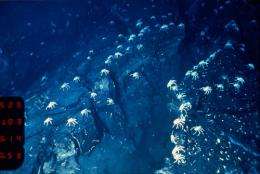
Scientists studying deep-sea hydrothermal vents have found that larvae travel hundreds of miles to re-colonize these harsh locations after a volcanic eruption. The new study could challenge existing beliefs about how life adapts to extreme environments.
In 2006, a team of scientists studying the migration of organisms at hydrothermal vents in the Pacific Ocean stumbled upon a volcanic eruption at one of the study sites. This event on the seafloor has made way for a new discovery that challenges existing beliefs about life at these extreme environments.
The findings, published in the April 12 issue of the Proceedings of the National Academy of Sciences (PNAS), suggest that tiny larvae travelled hundreds of miles to re-populate a hydrothermal vent after it endured a volcanic eruption that destroyed all adult life-forms.
“As a larval biologist, I think the most important aspect of this study is the idea that populations can change how connected they are to other populations over time,” said co-author Diane Adams, a guest investigator at the Woods Hole Oceanographic Institution (WHOI).
The interconnected nature of life on Earth, and how those relationships change over time, is an important aspect of astrobiology. By learning how life survives catastrophes, astrobiologists also can learn the limits to life, and the requirements necessary for life to colonize new environments.
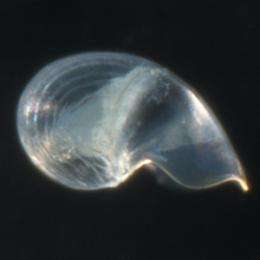
Riding the Currents
According to Adams, hydrothermal vents normally just expel a mix of gases and thermally- and chemically-altered seawater. The expulsion of molten lava occurred near the vents, and this eruption created a natural experiment that allowed the scientists to study how life reacts to and recovers from catastrophe.
"We were in a very fortunate position when the eruption was discovered because we had just retrieved the larval samples on the last cruise to that area to study larval dispersal and physical oceanography currents along this area of the mid-ocean ridge,” Adams said.
The research team compared vent populations before and after the volcanic event. Adams and her colleagues found that the larvae present at the vent after the eruption were considerably different from the species that had lived at the vent prior to the volcanic incident. What startled the scientists the most was the discovery of the Ctenopelta porifera species.
“The presence of Ctenopelta was surprising because the only known adult populations are found hundreds of kilometers away,” said Adams.
The researchers were baffled as to how the larvae managed to survive the long-distance underwater journey. Imagine an organism no larger than the thickness of a couple of sheets of paper traveling nearly 200 miles. That is what the Ctenopelta larvae did when they found their way to the vents at the study site.
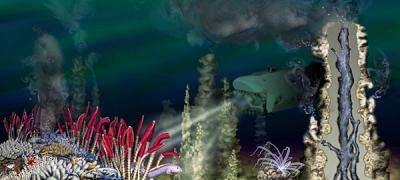
According to Adams, it’s a surprising finding since currents in the deep sea are generally pretty slow.
“We do know that it is their tiny larval stage that makes this journey,” Adams explained, “but the larvae are too small and weak to swim the distance.”
Researchers are focusing on two possible explanations. One is that the larvae “ride the currents.” Adams’s co-author Lauren Mullineaux and some colleagues from WHOI conducted a modeling study to try to show the presence of northward and southward jets along the ridge.
“However, there is a large transform fault in between our study site and the only known adult populations, which interrupts these jets,” said Adams.
The other possibility is for the larvae to travel along currents that are created when large eddies, originating off the coast of Central America, cross the ridge. Mullineaux and a colleague conducted another modeling study that showed these eddies had the potential to produce strong currents in the deep sea that could transport larvae hundreds of miles.
Marcelo Guzman, assistant professor in the Department of Chemistry at the University of Kentucky, said more proof is needed of how the larvae travel such distances successfully.
“Based on the time scale of this study, they still need to provide a faster mechanism or one that explains the extended larval lifetime to explain their observations,” Guzman said. “They also discarded high temperature differences but could not rule out the different chemistry dominating the vent before and after the eruption.”
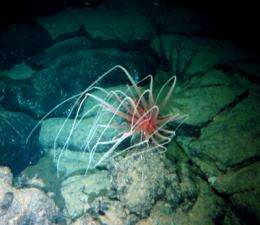
In searching for an explanation for the unexpected findings (such as the presence of the Ctenopelta larvae), factors such as temperature were ruled out since the pre-eruption and post-eruption temperatures at the site were similar. However, the scientists say that it is possible that the chemistry of the environment changed, and that could have affected what sort of life could survive at the vent in the aftermath of the eruption.
Adams, Mullineaux and their colleagues now have turned their attention to investigating how the larvae disperse long distances. They plan on taking a closer look at the role eddies and underwater jets play in connecting vent communities.
Connecting Life and Planetary Processes
The research, funded by the National Science Foundation (NSF), was a part of the NSF Ridge 2000 program that was initiated to study the linkages between life and planetary processes that take place at mid-ocean ridges.
The study sites were located along the East Pacific Rise (EPR) - a section of the mid-ocean ridge system that spans from near New Zealand to the Gulf of California, a couple of hundred miles off the coast of Mexico. The EPR forms the boundary of the Pacific and Cocos tectonic plates, which are separating at a rate of more than four inches every year. That creates a lot of volcanic activity and hydrothermal vents, making the ridge a prime location for studying how life originates, survives and interacts at these harsh environments.
One of the prevailing theories for the origin of life is that it started at such hydrothermal vent environments at least 3.8 billion years ago. While the eruption at this study site wiped out all of the complex life on the seafloor, bacteria and archaea, especially those in the subseafloor, were not completely eradicated. Adams said disturbances like volcanic eruptions are unlikely to effectively sterilize a vent and could actually be a catalyst for evolution.
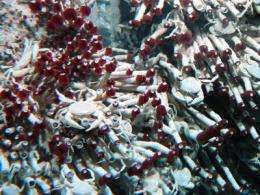
In other words, bacteria and archaea populations can survive the eruptions, and by eliminating the competition of the more complex life forms, the eruptions create more space for the single-celled life forms to thrive. Other factors that can also help create a conducive environment include the rapid changes in the surroundings and the gene pools, and the smaller population size of certain species that previously dominated the hydrothermal vent site.
A theory of evolution put forward by the Harvard paleontologist Stephen J. Gould is that sometimes dramatic changes can occur in a species in a very short period of time. This theory, called “punctuated equilibrium,” differs from the standard view that evolution occurs through steady incremental changes over very long periods of time.
Guzman suggested that the process observed in this study represents a "punctuated phenomenon" that produces rapid evolution.
These types of studies, he further noted, provide an opportunity to indirectly test the processes of the origin, evolution and future of life on Earth and, possibly, elsewhere in the universe.
“The results are exciting and open new scientific questions that deserve further investigations,” Guzman said.
Source: Astrobio.net



















